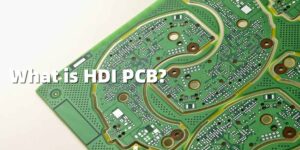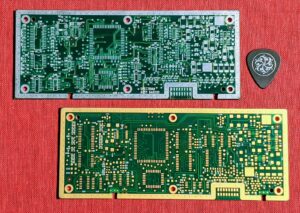High Density Interconnect (HDI) is a high density interconnect board, which is a circuit board with relatively high density of line distribution using micro-blind buried holes. HDI boards have an inner layer of traces and an outer layer of traces that are then connected inside each layer using processes such as drilling and metallization in the holes.
HDI boards are typically manufactured by lamination methods. The more layers are stacked, the higher the technical grade of the board. While normal HDI boards are essentially disposable laminates, higher-tier HDI uses two or more layers of technology with advanced PCB technologies such as stacked vias, plated vias, and direct laser drilling.
As the density of PCBs increases beyond eight-layer boards, boards made with HDI will cost less than traditional complex pressing processes. HDI boards promote the use of advanced packaging technologies and have higher electrical performance and signal correctness than traditional PCBs. in addition, HDI boards offer better improvements in RFI, EMI, ESD, thermal conductivity, etc.
Electronics continue to evolve towards higher density and precision. The so-called “high” reduces the size of the machine in addition to improving its performance. High density integration (HDI) technology allows for more compact final product designs while meeting higher standards of electronic performance and efficiency. Most of the current popular electronic products, such as cell phones, digital (camera) cameras, notebook computers, automotive electronics, etc., use HDI boards. As electronics are upgraded and market demand increases, HDI boards will grow very rapidly.
Plain PCB introduction
PCB (Printed Circuit Board) is the Chinese name for a printed circuit board, also known as a printed circuit board, which is an important electronic component, a support for an electronic component, and a carrier for the electrical connection of an electronic component. It is called “printed” circuit board because it is electronically printed.
The main function is to avoid manual wiring due to the consistency of the same printed circuit board when electronic devices are used, and to automatically insert or mount electronic components, automatically solder and automatically detect electronic components. The quality of electronic devices improves labor productivity, reduces costs, and facilitates maintenance.
HDI boards are high-density interconnect boards, blind-hole plated and secondary pressed boards are HDI boards that are classified as first-order, second-order, third-order, fourth-order, fifth-order and other HDI. for example, the motherboard of the iPhone 6 is a fifth-order HDI PCB.
A simple blind buried hole is not necessarily an HDI.
How to distinguish between first, second and third order HDI PCBs
First order is relatively simple and has well-controlled processes and procedures.
The second problem starts to get troublesome, one is alignment and the other is stamping and copper plating. There are multiple second-order designs. One is the interleaved position of each step. When connecting sub-adjacent layers, the wires are connected in the middle layer. This is equivalent to two first-order HDIs.
The second one is two first-order holes overlapping, and the second one is achieved by superposition. The processing is similar to two first stages, but there are many technical points that require special control, namely described above.
The third is to punch directly from the outer layer to the third (or N-2) layer. This process is very different from the previous ones and is much more difficult to punch.
For the third order, the second order analogy is.
Common PCBs are mainly FR-4, which is made of epoxy resin and electronic grade glass cloth. Normally, with traditional HDI, bonded copper foil is used on the outermost side, and because of laser punching, it is impossible to open the glass cloth, so bonded copper foil without glass fibers is usually used, but now high energy laser drilling has been able to penetrate 1180 glass cloth. This is no different from normal materials.















